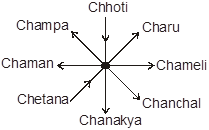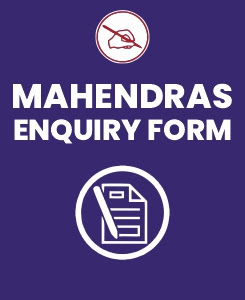
Dear Readers,
Mahendras has started special quizzes for IBPS & SBI Exam so that you can practice more and more to crack the examination. This IBPS & SBI Exam special quiz series will mold your preparations in the right direction and the regular practice of these quizzes will be really very helpful in scoring good marks in the Examination. Here we are providing you the important question of reasoning ability for the IBPS & SBI Exam.
Q.1-5. Read the following information carefully and answer the questions given below.
Chanchal, Chameli, Chetana, Champa, Chaman, Charu, Chanakya and Chhoti are sitting around a circular table with equal distance amongst each other but not necessarily in the same order. Only two people face the centre and the rest people face the outside. Chameli sits second to the left of Chanakya. Chanakya faces outside. Chetana sits third to the right of Chameli. Two people sit between Chetana and Chhoti. Immediate neighbours of Chhoti face outside. Chaman sits second to the right of Chhoti. One of the immediate neighbours of Chaman faces outside. Champa is not an immediate neighbour of Chameli. Charu is an immediate neighbour of Chhoti.
Q.1. Who is infront of Chameli?
(1) Chetana
(2) Chhoti
(3) Chaman
(4) Chanakya
(5) Champa
Q.2. Which of the following statement is not true?
(1) Chhoti faces towards the centre.
(2) Champa is second to the left of Charu.
(3) Chameli is between Charu and Chanchal.
(4) Chetana faces towards the outside.
(5) Chaman is neighbour of Chetana.
Q.3. Who is/are the immediate neighbour(s) of Charu?
(1) Chaman, Chameli
(2) Champa
(3) Chhoti, Chameli
(4) Chanakya
(5) None of these
Q.4. What is the position of Chanakya with respect to Chhoti?
(1) Fourth to the left.
(2) Immediate right.
(3) Immediate left.
(4) Fourth to the right.
(5) Both (1) and (4)
Q.5. Four of the following five are alike in a certain way based on their position and so form a group. Which is the one that does not belong to that group?
(1) Champa
(2) Chanchal
(3) Chameli
(4) Chhoti
(5) Chaman
प्र.1-5. निम्नलिखित जानकारी का ध्यानपूर्वक पढ़े और नीचे दिये गये प्रश्नों के उत्तर दीजिए।
चंचल, चमेली, चेतना, चम्पा, चमन, चारू, चाणक्य और छोटी एक वृत्ताकार मेज के गिर्द सभी एक-दूसरे से समान दूरी पर है। किन्तु जरूरी नहीं इसी क्रम में हो। केवल दो व्यक्ति केन्द्र की ओर देख रहे है और बाकी व्यक्ति केन्द्र के बाहर की ओर देख रहे है। चमेली, चाणक्य के बायें दूसरी बैठी है। चाणक्य बाहर की ओर देख रहा है। चेतना, चमेली के दायें तीसरी बैठी है। चेतना और छोटी के बीच में दो व्यक्ति बैठे है। छोटी के निकटवर्ती पड़ोसी बाहर की ओर देख रहे है। चमन, छोटी के दायें दूसरी बैठी है। चमन का एक निकटवर्ती पड़ोसी बाहर की ओर देख रहा है। चम्पा, चमेली की निकटवर्ती पड़ोसी नहीं है। चारू, छोटी की निकटवर्ती पड़ोसी है।
प्र-1. चमेली के ठीक सामने कौन है?
(1) चेतना
(2) छोटी
(3) चमन
(4) चाणक्य
(5) चम्पा
प्र-2. निम्न में से कौन सा कथन सत्य नहीं है?
(1) छोटी केन्द्र की ओर देख रही है।
(2) चम्पाए चारू के बाएं दूसरी है।
(3) चमेली, चारू और चंचल के बीच में है।
(4) चेतना बाहर की ओर देख रही है।
(5) चमन, चेतना का पड़ोसी है।
प्र.3. कौन चारू का निकटवर्ती पड़ोसी है/हैं?
(1) चमन, चमेली
(2) चम्पा
(3) छोटी, चमेली
(4) चाणक्य
(5) इनमें से कोई नहीं
प्र.-4. छोटी के सन्दर्भ में चाणक्य का स्थान क्या है?
(1) बाएं चैथा
(2) तुरन्त दाएं
(3) तुरन्त बाएं
(4) दायें चैथा
(5) दोनों (1) और (4)
प्र.5. निम्नलिखित पाँच में से चार अपने बैठने के आधार पर किसी निश्चित प्रकार से एक समान है और एक समूह बनाते है। निम्न में से वह एक कौन-सा है जो उस समूह में नहीं आता है?
(1) चम्पा
(2) चंचल
(3) चमेली
(4) छोटी
(5) चमन
Q.6-7. Read the following information carefully and answer the questions given below.
City Agra is 3 km north of City Bombay. City Calcutta is 6 km east of City Bombay. City Delhi is 2km south of City Calcutta. City Lucknow is 3 km west of City Delhi. City Faridabad is 5 km north of City Lucknow. City Gujarat is 3 km west of City Calcutta.
Q.6. What is the direction of City Agra with respect to City Faridabad?
(1) West
(2) North
(3) South
(4) North-east
(5) None of these
Q.7. Which of the following options is represents the square?
(1) Faridabad, Calcutta, Delhi and Lucknow cities
(2) Agra, Faridabad, Gujarat and Calcutta cities
(3) Bombay, Calcutta, Delhi and Lucknow cities
(4) Agra, Faridabad, Gujarat and Bombay cities
(5) Lucknow, Delhi, Gujarat and Bombay cities
प्र.6.7. निम्नलिखित जानकारी का ध्यानपूर्वक पढ़े और नीचे दिये गये प्रश्नों के उत्तर दीजिए।
शहर आगरा, शहर मुम्बई के 3 किमी. उत्तर में है। शहर कलकत्ता, शहर मुम्बई के 6 किमी. पूर्व में है। शहर दिल्ली, शहर कलकत्ता के 2 किमी. दक्षिण में है। शहर लखनऊ, शहर दिल्ली के 3 किमी. पश्चिम में है। शहर फरीदाबाद, शहर लखनऊ के 5 किमी. उत्तर में है। शहर गुजरात, शहर कलकत्ता के 3 किमी. पश्चिम में है।
प्र.6. शहर फरीदाबाद के सन्दर्भ में शहर आगरा की दिशा क्या है?
(1) पश्चिम
(2) उत्तर
(3) दक्षिण
(4) उत्तर-पूर्व
(5) इनमें से कोई नहीं
प्र.7. निम्न विकल्पों में कौन सा एक वर्ग दर्शाता है?
(1) फरीदाबाद, कलकत्ता, दिल्ली और लखनऊ शहर
(2) आगरा, फरीदाबाद, गुजरात और कलकत्ता शहर
(3) बम्बई, कलकत्ता, दिल्ली और लखनऊ शहर
(4) आगरा, फरीदाबाद, गुजरात और मुम्बई शहर
(5) लखनऊ, दिल्ली, गुजरात और मुम्बई शहर
Q.8. If it is possible to make only one meaningful English word with the second, third, sixth and seventh letters of the word ‘TELEPHONE’, which of the following will be the third letter of that word from the left? If no such word can be made, give ‘X’ as the answer and if more than one such word can be formed, give ‘Y’ as the answer.
(1) H
(2) L
(3) E
(4) X
(5) Y
प्र.8. यदि शब्द ‘TELEPHONE’ के दूसरे, तीसरे, छठे और सातवें अक्षरों से अंग्रेजी का केवल एक अर्थपूर्ण शब्द बनाना सम्भव हो, तो उस शब्द का निम्न में से कौन-सा बायें छोर से तीसरा अक्षर होगा? यदि ऐसा कोई शब्द बनाना सम्भव न हो तो अपना उत्तर, ‘X’ दें और यदि एक से अधिक शब्द बनाये जा सकते हैं तो उत्तर ‘Y’ दें।
(1) H
(2) L
(3) E
(4) X
(5) Y
Q.9. If each vowel in the word ‘COMPUTERISED’ is changed to next alphabet according to the English alphabetical series and each consonant changed to the previous letter, how many such pairs of letters are there in the new word thus formed each of which has many letters between them in the word as they have between them in the English alphabet?
(1) None
(2) One
(3) Two
(4) Three
(5) Four
प्र.9. यदि शब्द ‘COMPUTERISED’ के प्रत्येक स्वर को अंग्रेजी वर्णमाला के अगले अक्षर से और प्रत्येक व्यंजन को पिछले अक्षर से परिवर्तित कर दिया जाता है तो इस प्रकार बने नये शब्द में अक्षरों के ऐसे कितने जोड़े है जिनमें से प्रत्येक के बीच शब्द में उतने ही अक्षर है जितने की उनके बीच अंग्रेजी वर्णमाला में होते है?
(1) कोई नहीं
(2) एक
(3) दो
(4) तीन
(5) चार
Q.10. The following question is based on the following alphabet-series.
A B C D E F G H I J K L M N O P Q R S T U V W X Y Z
Which letter would be exactly in the middle of the fourth letter from the right end and seventeenth letter from the left end?
(1) R
(2) S
(3) T
(4) U
(5) None of these
प्र.10. निम्नलिखित प्रश्न नीचे दी गयी अक्षर/संख्या शृंखला पर आधरित है-
A B C D E F G H I J K L M N O P Q R S T U V W X Y Z
निम्न में से कौन सा अक्षर बायें छोर से सत्रहवें और दायें छोर से चैथे अक्षर के एकदम मध्य में होना चाहिए?
(1) R
(2) S
(3) T
(4) U
(5) इनमें से कोई नहीं
ANSWER-
Q.1-5.


Q.1.(3)
Q.2.(4)
Q.3.(3)
Q.4.(5)
Q.5.(4)
Q.6.(1)
Q.7.(4)
Q.8.(2)

Hole
Q.9.(5)
Q.10.(3)





0 comments:
Post a Comment
MAHENDRA GURU